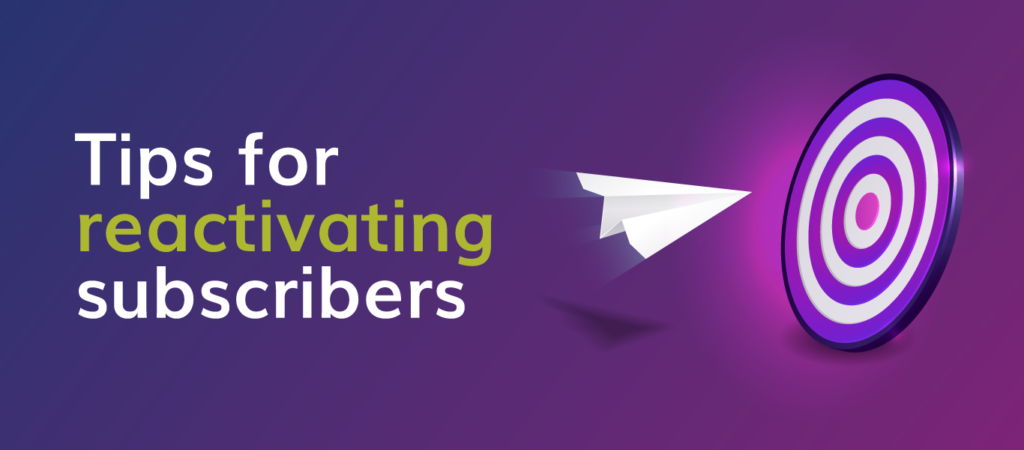Did you know that email lists have a natural attrition rate of about 22.5% per year? As marketers, we know how much work went into building and growing your email list, so it can be hard to say goodbye to subscribers, whether they’ve simply changed their email address or haven’t opened any of your emails for the last three months.
If you have subscribers that are no longer engaging with your emails, you don’t have to immediately purge them from your list. There are steps you can take to win back the heart of your subscribers – and their inbox. Check out the advice on reactivating and repermissioning subscribers from our panel of experts this month.
Kate Barrett, Founder of eFocus Marketing

Kate Barrett is the founder of eFocus Marketing, providing specialist email marketing consultancy, management, and training services to companies around the world.
With a proven track record and over 14 years’ experience (increasing results from opens and clicks, to sales), Kate’s expertise and passion has helped a large range of companies develop comprehensive strategies, to target subscribers with the right message, sent to the right person, at the right time, implement, manage and optimise those campaigns, as well as solve complex email marketing issues including deliverability challenges.
Kate is the author of the book ‘E-telligence. Email Marketing isn’t dead, the way you’re using it is’
When it comes to the health of your email list, you have to consider the type of disengaged subscriber that you’re dealing with. They aren’t all created equal. Here are three key areas to work through:
Your data
Do you have any other data about these disengaged subscribers beyond how they are responding to your emails? When was the last time they made a purchase? Have they ever made a purchase? What type of buyer are they? What other data do you have around their behaviour in different areas – e.g. website activity, social media activity, engagement with other channels?
With this data, you can build a detailed profile of your inactive subscribers and deal with them on a more personalised basis. For example, those subscribers who’ve never made a purchase and haven’t engaged in a long time [insert time period depending on your business lifecycles] are much colder prospects than a disengaged email subscriber who is still buying from you regularly; and everyone in between.
Reactivate vs. re-permission vs. reduce vs. delete
Understanding what types of disengaged subscribers will help you make an informed decision for each type as to whether to reactivate, re-permission, delete, or simply reduce their frequency. Each of these different strategies offers its own benefits.
A multi-pronged approach
Whichever of these strategies you choose, make sure you send a series of emails over time before making any final decisions about removing your subscribers. Give people at least a few weeks to respond positively.
If subscribers are still not engaging with your emails, it’s probably best to scrub them from your list. Continuing to engage with subscribers that don’t want to hear from you can actually hurt your brand, leading to resentment in the inbox, or being marked as spam. Instead of focusing on those that don’t want to hear from you, you can turn your attention to those that do – improving your segmentation strategy, developing content that resonates with your engaged subscriber, and working to build your list.
Skip Fidura

Skip is a globally recognised data marketer whose high energy presentations avoid buzzwords to put complex concepts into plain actionable language.
His talks focus on using technology to have real conversations with customers, consumer centric uses for data and responsible marketing.
There is an urban myth that a famous marketer once said, “Half of my ad spend is wasted. I just don’t know which half.” It is a brilliant story for another day, but the same thing holds true here. I know that half of my audience is unengaged, but I do not know which half. At least not until I very clearly define what it means to be engaged.
I have a fifteen-year-old and you can never really be sure what they are going to care about. If they are quite excited by something, it is a safe bet that they care about it. If they seem blasé and shrug something off however, they will care more than you expect about 50% of the time.
This reminds me of the challenge we face. We rely on reader behaviour as digital body language to understand what resonates and what falls flat. Like my fifteen-year-old, our email recipients do not always display the behaviour that we understand as engagement but that does not make them any less engaged.
The logical first step to any reengagement programme is understanding your customers’ behaviour. The natural place to start is with your openers and clickers. Are they engaging with other channels, visiting your site, still buying? Then look at your non-openers and non-clickers. Are they coming to your site? Most importantly, are they still buying?
However, there is something more important than any of these questions. What have you changed which will keep people engaged? What you were doing when they became unengaged clearly was not working, so you need to have changed your approach before you spend money on a reengagement programme. Or, to use another urban myth quote, “the definition of insanity is doing the same thing over and over again and expecting different results.”
Lauren Meyer, EVP of Product Marketing & Brand Strategy at SocketLabs

Lauren brings more than 14 years of experience in the email industry to her role as EVP of Product Marketing & Brand Strategy for SocketLabs. Throughout her career, Lauren has helped small and large-scale senders get the most out of their email marketing programs, working with various ESPs and email technologies. Having focused mainly on the areas of deliverability, anti-abuse and compliance, Lauren is a vocal advocate for having a proactive, data-driven approach to email best practices and deliverability monitoring as a means to optimizing email performance and the recipient experience.
Acquiring new customers is hard. It’s also expensive — costing up to 5x more than retaining existing customers, and driving less conversions. Which is why a healthy reactivation strategy should be a regular part of your brand’s email program.
But reactivation efforts can lead to inbox placement issues stemming from spam complaints, blocklistings, spam trap hits and high bounce rates, so the key to success is a thoughtful and cautious approach. Before hitting send, ask yourself the following:
When did you last email them?
In general, sending infrequently isn’t great for the recipient experience. And the longer it’s been since someone has heard from you, the more likely it becomes that they’ll forget they signed up, or find your content irrelevant. You may also hit recycled spam traps if you’re sending to email addresses that haven’t been contacted in more than 6-12 months. So if you haven’t stayed in regular contact with portions of your email audience, consider suppressing them from your reactivation efforts.
How engaged did they used to be?
Dig into your email metrics and focus your strategy around the recipients who are the most likely to fall back into the active part of your database, starting with those who engaged most recently, and working your way through less and less engaged segments (i.e. “opened or clicked within 60-90 days”, then “…90-120 days”, and so on).
Roll out your reactivation efforts slowly, allowing for time to review the initial results, stay ahead of any potential risks to deliverability, and adjust accordingly at the first sign of a problem.
At some point, the risks to inbox placement will outweigh the reward, so be prepared to stop the exercise as soon as the results are outside your pre-established comfort level (i.e., when spam complaints exceed a certain level, or when your deliverability monitoring tools are detecting spam traps or blocklistings leading to delivery issues).
Saul Gowens, Founder of Websand

Saul Gowens, founder of Websand, an email marketing platform designed to support ecommerce growth. Saul has been involved with data, customer retention, loyalty, and email marketing since 1999, working with clients all over the globe to help them surprise, delight and retain their customers.
I’m going to mention the 80/20 rule a lot in these tips, mostly to show how important it is to have strategies in place to deal with reactivating customers and subscribers.
Let’s start with where the money is, your customers. In our experience typically 80% of your customers aren’t coming back for a second purchase. I’m assuming you have amazing service and sell fantastic products / service. That being the case, the main reason they don’t come back is you don’t have a focused customer reactivation programme. Imagine the difference to your business if you could increase your returning customers by even a few %. Read more on that in our Second Sale Void blog post.
For reactivating subscribers – The average open rates are 20% of the audience on a campaign. That means 80% don’t respond. (note – it’s actually 18%, but I’m doing the 80/20 thing here so forgive me). That’s on a single campaign, if you look at things over a wider time period, it’s probably going to be closer to 40% engaged / 60% not engaged. That’s on a typical newsletter audience.
Now what to do with the unresponsive subscribers, it’s a 3-step process.
- Should you try to re-engage with subscribers? This links with your data retention policy, so if your rule is to remove people with no engagement over 12 months, that is your line for re-engagement, if they are beyond that time, then you should be removing that data, rather than re-engaging.
- Once you’ve set your reactivation time benchmark, the second question is setting your reactivation objective, how are you going to re-engage with subscribers and for what purpose? Is it a sales process or something else?
- Then it’s a case of putting a re-engagement process in place, testing the response, and then learning / improving from that point onwards.
April Mullen, Director of Brand and Content Marketing at SparkPost; Co-Founder and Board Member, Women of Email

April Mullen is currently the Director of Brand and Content Marketing at SparkPost. She has over 14 years working in email for brands, agencies and in martech.
Outside of SparkPost, Mullen has been an Adjunct Professor of Digital Marketing at the University of Missouri-St. Louis since 2013. In June of 2016, Mullen co-founded Women of Email, an organization with over 5,000 members on six continents that is aimed at driving positive change for women in the email marketing niche.
Mullen was named to DMNews’ 40 Under 40 list in 2018 and DMNews’ 2019 Marketing Hall of Femme Women to Watch list. She contributes thought leadership at conferences and through writing for industry publications, including Forbes and MediaPost.
Similar to active recipients in your database, inactive recipients can also be segmented, targeted, and treated differently. Here is an example of how to manage inactive records up to the one year mark. It’s important to note that your company’s window might need to be tightened based on your business. The framework can still work for you with an adjustment to the time frames.
1) At-Risk (haven’t opened or clicked on an email in 60-90 days). With this group, driving any kind of email engagement is the goal. Consider targeting a specialized, limited-time-only promotion based on their most recent behaviors in other channels. Contextual marketing tactics like in-email polls, surveys, and personalized imagery are also proven methods to drive clicks with this audience. Consider developing a series of campaigns employing a variety of methods to prevent continued lapse.
2) Lapsing (haven’t opened or clicked on an email in 90-180 days). These individuals are past the threshold, so a straightforward approach is best. We miss you, opt-down, and re-permission-type messaging work well for this audience. Remind them of what they will be missing by not receiving your emails. Again, consider sending a series of campaigns. Be clear that you will no longer email if no activity is taken after a period of time.
3) Inactive (haven’t opened or clicked 180+ days). It’s best not to email these recipients, since that may cause severe deliverability issues. Instead, take a re-permission approach. Ask them to opt back into the email program via other channels. Your website, mobile app or your online/call-in reservation program are good places to start.
For all segments, test a variety of content and calls to action to re-engage subscribers to find a winning combination. Automate the messages once a winning sequence is identified and then plan to continually test and optimize as audience behaviors change over time.
If, after all this effort, an inactive or dormant subscriber doesn’t open or click, let them go and focus your energy on those who do.
Guy Hanson, VP for Customer Engagement at Validity

As VP for Customer Engagement at Validity, Guy is a highly respected digital marketing professional and data storyteller. He’s a passionate advocate for intelligent use of customer data to drive responsive programs, and has developed this belief over the past 2 decades to become one of the UK’s leading email marketing experts. Guy is an accomplished thought leader, having spoken at well over 100 industry events, and blogged on a broad range of email-related topics that include politics, GDPR, and Brexit! Outside of work, he has a long-standing relationship with the Data & Marketing Association (DMA UK) and is currently vice-chairing of the email council.
Re-activation means email programs first need to identify when this should happen. A DMA/Validity report shows only just over half of programs (58%) have inactivity rules in place, and only half of those (57%) have rules specific to major domains (Gmail, Outlook, etc). This is important – on average inactivity flags are set after 150 days of no life, yet Gmail’s sender guidelines clearly state “Send emails to engaged users”, and their “Inbox Tip” cards prompt users to unsubscribe from email programs where they haven’t opened in the past month. So there’s a 4-month gap between Gmail’s definition of inactivity compared with typical senders . . . creating a self-fulfilling prophecy as unopened emails start re-routing to recipients’ spam folders.
A reason for this gap is that senders don’t just view inactivity through the lens of email responsiveness. While they use metrics like opens and clicks to measure activity, they’ll also consider factors like last purchase, last login, and last website visit. Rightly so – DMA research shows clicks are only one of several actions interested recipients take. They may visit the sender’s website, view their social media pages, phone their helpline, or visit a physical stores. All are positive actions, and with an average email CLV of £34 senders absolutely shouldn’t suppress good addresses too soon!
So, how to square this circle? The trick lies in implementing email re-activation earlier (to stimulate those open/click metrics) but without using generic win-back messaging like (they don’t necessarily need winning back – yet!). We’ve learned from the pandemic that useful information is a great engagement driver so introduce it earlier in your subscriber lifecycle. We’re not talking lame ““we miss you – here’s a discount voucher!” messages here! Rather, provide how-to guides, value statements, and functionality like preference centres to offer choice over content and frequency.
Remember your customers may still be fully engaged with your brand, and just a proactive tweak in messaging strategy is needed to reanimate them.




